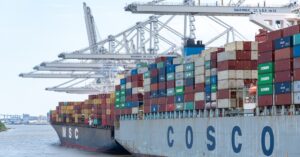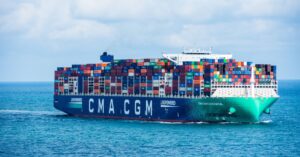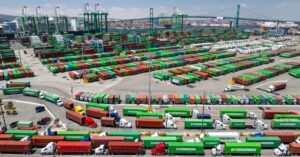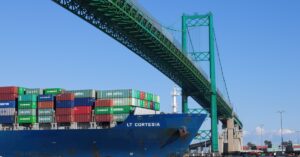Have you developed whiplash yet from trying to keep track of the Trump tariffs and their impact on logistics and supply chain?
With the current pause on most threatened tariffs to allow for bilateral negotiations — or with a trade bloc like the EU — plus a temporary reduction in duties on Chinese imports from 145% to 30%, container volumes in both the west and east coasts are surging along with spot rates. This reverses a monthslong decline as earlier anticipatory front-loading tailed off. Trump and Xi have started talking, apparently a good sign, but rhetoric from Xi seems to signal a quick result isn’t in the cards.
And there’s another wrinkle in the trade wars. On May 28, the Court of International Trade (CIT) handed down a ruling that said Trump lacked constitutional authority to unilaterally impose tariffs under the Emergency Economic Powers Act (EEPA). Hours later, the decision was stayed pending a ruling by an appellate court. California, meanwhile, has sued the Trump administration, claiming the same lack of constitutional authority; that case may wind up before the CIT. Stay tuned.
Nearshoring and regional freight networks are ways shippers can hedge against the impact of unpredictable duty rates, helping them stabilize costs and service. By shifting production closer to demand and leveraging regional transport corridors, you can partially insulate your supply chain from the tariff shocks.
The Challenge of Tariff Volatility
According to data from Drewry, its World Container Index, a closely watched metric on freight rates, spiked 70% between May 8 and June 5, due to a surge in U.S.-bound traffic during the tariff pause.
Freight rates on 40-foot containers from Shanghai to Los Angeles rose 57% for the week ended June 5, to $5,876, and are up a whopping 117% since May 8. Spot rates to New York were up 39% for the week and nearly doubled (96%) between May 8-June 5.
Rates for 40-foot containers have been on a roller-coaster ride in 2025, per Drewry. From a high of nearly $4,000 on January 9 on the back of front-loading, rates plunged to $2,076 on May 8, but then spiked to $2,508 as of May 29. They sat at $3,527 as of June 5. All of this has sent landed-cost forecasts into turmoil as the freight needle swings wildly.
The resulting unpredictability throws off landed-cost planning, leading many shippers into reactive decisions: scrambling to hedge inventory, absorbing unexpected surcharges, or passing costs along. In today’s climate, however, traditional pass-throughs won’t do the trick. Shippers need proactive strategies that provide greater control over sourcing and transportation.
Nearshoring as a Tariff Hedge
For many companies, Mexico has emerged as a top nearshoring candidate under the USMCA framework, offering proximity, reduced exposure to high-duty origins, and often zero or reduced tariff status.
And the market is paying attention. In the first quarter of 2025, Mexico saw a record $21.4 billion in foreign direct investment (FDI), driven by tariff uncertainty. Meanwhile, Mexico’s share of U.S. imports rose from 13.4% to 15.8% between 2017 and 2024, while China went in the opposite direction (21.6% to 13.2%).
Operational Advantages
- Shorter lead times: Nearshoring slashes time in transit and reduces the need for bulky safety stock.
- Lower surcharges: Shorter ocean routes or overland transport from Mexico mean lower fuel and port handling fees.
- Port efficiency: Avoid the congestion and container dwell risks seen in long-haul international ports.
Factors to Consider
- Labor and infrastructure costs: While nearshoring often reduces transport and tariff expenses, wages and facility costs may be higher compared to Southeast Asia. Shippers must weigh total landed costs, not just labor rates.
- Supplier network: Many nearshore regions are still developing the deep-tier supplier ecosystems that Southeast Asia offers. You may need to vet or help develop suppliers to meet quality and volume expectations.
- Feasibility and ramp-up time: Shifting production or distribution from China or Southeast Asia to Mexico or Central America is a significant undertaking. Site selection, facility buildout or retrofitting, workforce training, and establishing local compliance and certifications can take six to 18 months or more, depending on the complexity of your operation.
- Inventory transition planning: During the shift, companies often need to dual source or carry buffer inventory to maintain service levels, which can temporarily increase costs and complicate coordination across geographies.
Regional Freight Networks and Modal Diversification
The second layer of protection comes from rethinking how freight flows once goods reach North America. Regional freight solutions allow shippers to control costs, route around congestion, and speed up time to market.
Secondary Ports and Overland Corridors
- Shift volume away from West Coast ports to Gulf and East Coast terminals.
- Use Mexico-U.S. trucking corridors to access U.S. markets quickly under favorable trade rules.
- Consider inland ports and cross-border rail hubs to bypass congested coastal gateways.
Intermodal and Short-Sea Shipping
- Combine rail and truck to optimize cost and efficiency across middle-mile networks.
- Explore short-sea routes along the Gulf and Atlantic coasts, especially for freight that doesn’t require next-day delivery.
Strategic Warehousing Hubs
- Position distribution centers near border zones or inland free-trade zones (FTZs).
- Use cross-dock operations to reduce dwell and reroute goods directly to final markets.
- Pre-position inventory to maintain service levels during rate or tariff shifts.
Integrating Nearshoring and Regional Freight Strategies
For maximum effectiveness, shippers must align internal and external operations into one agile ecosystem. This is where a provider of 3PL solutions can offer insights borne of years of industry experience.
- Collaborative planning: Synchronize procurement, production, and logistics teams to map optimal trade paths and avoid tariff-prone origins.
- Flexible network design: Integrate bonded storage or FTZs into the distribution model to defer or reduce duty payments.
- Dynamic mode shifting: Use real-time freight visibility tools and TMS to shift modes based on transit time, availability, and cost.
- Risk mitigation: Diversify origin points, carriers, and lanes to maintain agility in response to tariff or capacity disruptions.
Building a Buffer Against Tariff Impacts
Tariff volatility may be a fact of life for the foreseeable future, but shippers aren’t powerless. By shifting production closer to demand and building regional freight agility, you can reduce exposure to global freight shocks while keeping costs and service levels steady.
At COGISTICS Transportation, we help manufacturers and distributors create resilient, flexible logistics strategies by integrating nearshoring with regional carrier networks, warehousing, and real-time visibility. When every second counts, we’re ready with reliable expedited freight services.
Whether you’re looking to evaluate cross-border options, reroute around congestion, or build a scalable nearshoring strategy, COGISTICS Transportation is ready to help. We provide targeted solutions across air, land, and ocean freight operations, including convenient port-to-door services.
Want to make your supply chain more tariff-proof? Contact COGISTICS Transportation today to explore a smarter, more stable freight solution.




